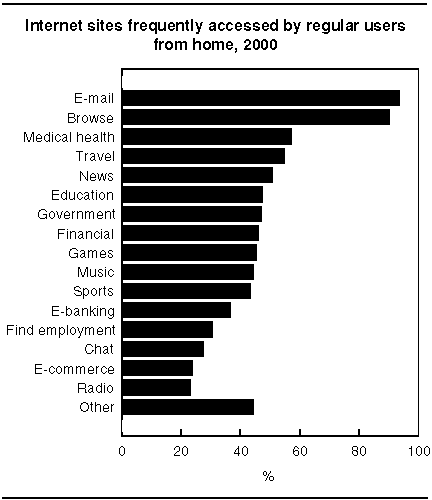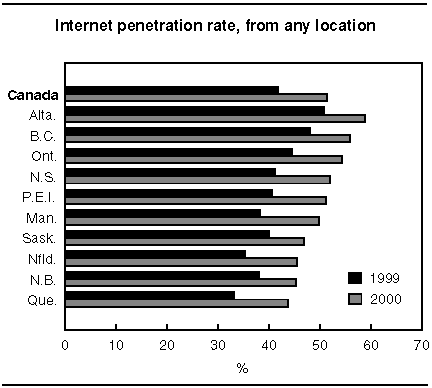
















 |
|
 |                |
Archived ContentInformation identified as archived is provided for reference, research or recordkeeping purposes. It is not subject to the Government of Canada Web Standards and has not been altered or updated since it was archived. Please "contact us" to request a format other than those available. 
The Daily. Thursday, July 26, 2001 Household Internet Use Survey2000Internet use took its biggest jump ever in 2000, according to the Household Internet Use Survey, dampening speculation that the Internet's popularity may be levelling off. In 2000, 51% of all Canadian households measured had at least one member who was a regular Internet user from one location or another. This was an advance from 42% in 1999, the last time the survey was taken. This was the fourth year for the survey, which measures Internet use by households from home, work, school, public libraries and various other locations. It covered almost 34,000 households. The biggest increase occurred in the proportion of households with at least one regular user who said the home was the most popular place from which to surf the World Wide Web. In 2000, about 40% said home was the most common place of use, compared with 29% in 1999. Regular household Internet use from work rebounded in 2000 after declining in 1999. About 28% of households had someone who used the Internet at work in 2000, compared with 22% in 1999 and 23% in 1998. About one in five households had someone who regularly used the Internet at school, the third most popular location. In 2000, just over 6.9 million households, or about three of every five, reported having at least one member who had used the Internet at least once in their lifetime. This was a 22% increase from 1999. Strong growth in Internet connection by cableThe survey found strong growth in the number of households connected by cable line to the Internet - as opposed to dial-up access by telephone line. In 2000, an estimated 1.0 million households were connected by cable to the Internet, 155% more than in 1999. In contrast, just over 3.7 million households were linked by telephone to the Internet, a growth rate of 29%. About 78% of households were connected to the Internet by telephone, and the remainder by cable.
Frequency and duration of use from home both on the riseHouseholds are accessing the Internet more frequently, and they are staying online longer, according to the survey. In 1999, 65% of households had at least one person who regularly used the Internet from home a minimum of seven times a week. In 2000, that proportion was 71%. Similarly, in 1999, about 47% of households had someone who spent 20 hours or more a month on the Internet. In 2000, 61% of households had a member who was doing so. The vast majority of households regularly accessing the Internet from home used e-mail and browsed the Web, according to the survey. But the Internet was also popular for other uses. About 57% of households searched for medical and health-related information. About 37% used it for electronic banking, and about 31% used it to find employment. 
Higher Internet penetration ratesAll provinces showed increased Internet penetration rates. In Quebec, 44% of households accessed the Internet from any location in 2000 - the lowest proportion of any province. However, that was an advance from 33% in 1999 - the biggest proportionate growth of any province. Alberta had the highest proportion in both years. Almost 59% of households in Alberta accessed the Internet from any location in 2000, up from 51% in 1999. Prince Edward Island, Newfoundland and Quebec had the highest growth rates for access from home. 
Higher-income households still more likely to use the InternetHigher-income households were still more likely to use the Internet, as were households whose members had higher levels of education. However, households with annual household incomes less than $36,000 posted a higher growth rate (41%) for use from any location than did those households with incomes greater than $36,000 (18%). Internet penetration increased for all age groups and family types, although Internet use among seniors was still much lower than among younger households. Households headed by members aged 35 to 54 using the Internet from any location grew 22% from 1999. However, Internet use in households headed by seniors grew 41%. A larger share of all households used the Internet in 2000 than in 1999, although there remains a big difference in penetration rates across family types. Single-family households with unmarried children aged 18 and under had the highest Internet penetration rates. Nearly 7 of 10 of these households accessed from any location. Access rates are particularly high among households with children because many of these children access the Internet from school. In fact, 40% of households with children had someone who used the Internet at school, compared with only 11% of households without children. However, this does not imply that children are the only cause of differences in access rates from home. Other factors, such as level of education, income and use of the Internet for work-related activities, may have as much to do with the differences in penetration rates for use from home. Privacy issues becoming less of a concernPrivacy issues are apparently becoming less of a concern for households. About 40% of respondents reported in 2000 that they had no concerns about privacy, compared with about 33% in 1999. However, that left almost 60% of households reporting that they were concerned or very concerned about privacy on the Internet. Privacy is defined as concern that personal information is accessible to others on the Internet, such as people finding out about the Web sites that household members visited, or the fear of others reading their e-mail. More than two-thirds of respondents indicating regular use from home stated they were concerned about Internet content that might be viewed by household members under the age of 18. Pornography was cited as an example by more than three-quarters of these households. Chatting with strangers and violence were also mentioned as concerns. Additional data tables related to the information presented in this series are available on Statistics Canada's Web site (). From the Our products and services page, choose Free Publications, then Communications, then Internet use in Canada, then Table of contents, then Charts and Graphs. For more information, or to enquire about the concepts, methods or data quality of this release, contact Jonathan Ellison (951-5882, jonathan.ellison@statscan.ca). Science, Innovation and Electronic Information Division. |
|
|
|